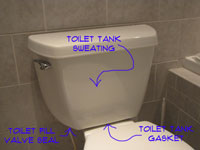 Learning how to fix a leaking toilet tank starts with determing what your problem is.. There are three likely possibilities for a leaky toilet tank. The first is the seal between the tank and the bowl. The second is the seal at the toilet fill valve.
Learning how to fix a leaking toilet tank starts with determing what your problem is.. There are three likely possibilities for a leaky toilet tank. The first is the seal between the tank and the bowl. The second is the seal at the toilet fill valve.
A third possibility is a cracked toilet tank. One other problem that is not really a leak is condensation on the toilet tank that drips onto the floor making a mess.
Not sure if this is your problem? See our complete 'Toilet Troubleshooting Guide' to narrow down the possibilites.
Tightening a Toilet Tank Seal
Most toilets are made of two porcelain castings, the toilet bowl and toilet tank. These two parts are connected together to form the toilet. There is a large rubber seal at this connection that keeps the water inside of the toilet. Two or more bolts hold the tank to the bowl unit. When tightened, these bolts compress the seal to make a watertight joint.
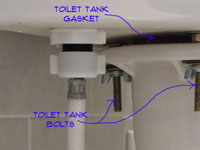 You have likely guessed where this is headed. The bolts can loosen over time and the seal will start to leak. As long as the seal is in good condition, you can tighten the bolts to stop the leak. This repair requires a large screwdriver and an adjustable wrench.
You have likely guessed where this is headed. The bolts can loosen over time and the seal will start to leak. As long as the seal is in good condition, you can tighten the bolts to stop the leak. This repair requires a large screwdriver and an adjustable wrench.
(1) Shut the water off to the toilet, using the valve at the water supply line.
(2) Take the lid off of the toilet tank. You can flush the toilet at this point to drain most of the water out of the tank. Hold the toilet flapper open to get as much water out of the tank as possible.
(3) In the center of the toilet tank you should see the toilet flapper that is attached to the toilet flush valve. The flush valve has a vertical fill tube attached to it.
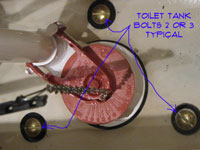 Around the flush valve there will be two or three bolt heads with rubber washers on them. The bolts are secured in place with nuts and washer that are found underneath the toilet tank.
Around the flush valve there will be two or three bolt heads with rubber washers on them. The bolts are secured in place with nuts and washer that are found underneath the toilet tank.
(4) With the large screwdriver in one hand and an adjustable wrench in the other, you can tighten the tank bolts. Use the adjustable wrench to hold the nut from spinning and use the screwdriver to do the tightening.
You want to tighten the bolt evenly, since this also levels the tank. Try a half turn or so for each bolt. If they feel loose, tighten them until the feel snug.
(5) Fill the tank up and check for leaks. If it is still leaking, you will want to try again. When repeated tightening does not solve the problem, it is possible that the seal is bad and needs to be replaced. See the article 'Replacing a Toilet Tank Gasket' for instructions on how this is done.
Tightening a Toilet Fill Valve
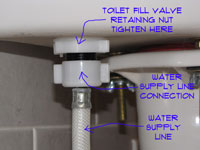
The toilet fill valve provides the water that your toilet uses to work. The toilet tank has a hole in the bottom for the fill valve. The fill valve is held in place by a large nut and a rubber washer.
The washer creates a seal that keeps the water from leaking out around the hole in the bottom of the tank. Tightening the nut will usually stop a leak at this location.
You will need a pair of adjustable pliers for this repair. They need to be large enough for the nut at the base of the tank.
(1) Shut the water off to the toilet, using the valve at the water supply line.
(2) Take the lid off of the toilet tank. You can flush the toilet at this point to drain most of the water out of the tank. Hold the toilet flapper open to get as much water out of the tank as possible.
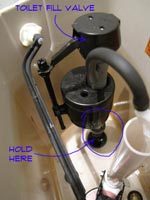 (3) The toilet fill valve is a vertical pipe that is usually on the left side of the tank as you face the toilet. It has a float attached to it that controls when the water shuts off.
(3) The toilet fill valve is a vertical pipe that is usually on the left side of the tank as you face the toilet. It has a float attached to it that controls when the water shuts off.
(4) Hold the base of the flush valve with one hand to keep it from spinning. Using a pair of adjustable pliers, tighten the nut that is directly below the bottom of the tank. There are two nuts at this location, one for the water supply line and one for the toilet fill valve. Be careful not to overtighten, these are usually plastic fittings.
(5) Turn the water back on and check for leaks. If the seal is still leaking after tightening, you may need to replace the rubber washer or the entire fill valve assembly. See the article, 'Toilet Fill Valve Repair' for more information.
Fixing a Cracked Toilet Tank
A crack in a toilet that is leaking may be difficult to repair. There are porcelain repair kits available that can be purchased. Some of them use a fiberglass mesh, this style would need to be used on the inside of the tank. All of them use some type of epoxy.
(1) Purchase a porcelain repair kit.
(2) Shut off the water and drain the tank, by flushing the toilet.
(3) The surface will need to be dry before the repair can be made. Let the tank dry completely for several hours. You can use a hair dryer to speed up the process.
(4) Carefully follow the instructions for the repair kit and patch the crack.
(5) Allow to dry thoroughly before refilling the tank.
Toilet Tank Condensation
This problem is not really a leak. Instead it is a result in differing temperatures and humidity. At times this problem can make a mess on your floor, requiring extra work to mop up the excess water.
The condensation occurs when the tank fills with cool water, usually around 50 to 60 degrees, and the room temperature is much warmer. The humidity in the air will cause the moisture in the air to condense on the cool surface of the toilet tank. Water droplets will form and run down the side of the tank.
After the water temperature inside of the tank adjusts to the room temperature, the condensation will stop. There are a few things that can help, and a few rather expensive solutions that are listed below.
(1) They make insulating blankets for toilet tanks. These may not solve the problem entirely, but they also absorb any water that does condense, thus reducing the mess.
(2) You can try running the a fan inside the bathroom to increase the air circulation.
(3) Adjusting the room temperature with your homes air conditioning system. If the difference in temperature is reduced the condensation will be reduced in a corresponding amount.
(4) There are also more expensive tempering valves and tempering tanks. The idea would be to fill the tank with water that is already at room temperature. These solutions will involve plumbing modifications to your home.
How To Fix a Leaking Toilet Tank – Summary
From the above, you can see that there are several places that a toilet tank can leak. This article should have provided the information you need to fix the problem and get rid of the leak.

